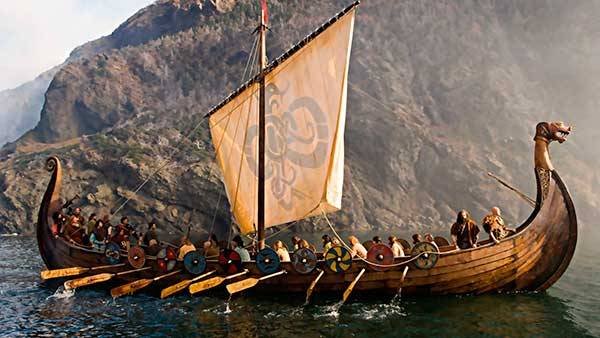
SHIPS AND SHIPS
The ships and ships part of their beginning both Egypt and Mesopotamia that were divided by rivers and canals, the promotion of water transport became necessary for successful trade and communications. Rafts constructed with bundles of reeds were used since very early times, and appear as a pictographic sign on a clay tablet of ca. from 3500 a.C. The raft has remained a popular vessel in the swamps of the S of Mesopotamia. The boat model in clay found in Eridu and which belongs to the year 3500 a.C. approx. It is very similar to the round (quffa) nacelle made of wood and leather that appears in an Assyrian relief sculpture from about 870 BC. and that is still used in the Euphrates River. Leather rafts, inflated or filled with straw, are other types of old boat with a long and continuous history. The official transport in Sumer, however, was made in ships with high prows and stern and oscillating, which were driven by oars or rods or perhaps sometimes thrown from the shore.
In Egypt the oldest ships were replicas of reed boats, and although the shape of the hull evolved in accordance with the possibilities of the wood, the decorative motifs such as the common lotus buds on the reed ships continue. In addition to the many representations of ships in the decoration of tombs, the knowledge of the Egyptian ships has been greatly facilitated by the discovery of vessels of the time. The oldest one was found next to the Pyramid of Cheops in Giza (ca. 2600 a.C.) and is 43, 40 m long; two more, about 10 m long, were found in Dahshur and belong to the 12th dynasty (1991-1786 a.C.).
In the Old Testament
Even though the Hebrews did not constitute a maritime town, their geographical situation made it impossible for them not to have contact with sailors and their ships. The tribes of Zebulun, Issachar, Dan, and Asher once had territories bordering the sea (Gen. 49.13; Dt 33.19; Judg 5.17), and the neighbors of Israel, the Phoenicians and the Philistines, were important maritime powers. The ship, however, remained a source of amazement to the Hebrews (Pr 30.19), and a sure passage was considered a demonstration of the goodness and power of God (Ps 107.23-30). The movement of the boat reminded the drunkard (Pr 23.34), and its speed the course of life (Job 9.26)
The word heb. customary for ship, ˒ ° niyyâ, most commonly refers to maritime merchant ships (eg Pr. 31.14) which are often described as "ships of Tarshish" (1 R. 22.48s). Whether or not Tarsis should be identified with a geographical location such as Tartessos in the S of Spain or Tarsus in Cilicia, or that is thought to mean something like "ore transporter", the ship described in this way is a Phoenician merchant ship of great autonomy. Barnett (Antiquity 32, 1958, pp. 226) believes that Phoenician cargo ships with round bows that appear in relief sculptures of Sennacherib (ca. 700 a.C.) are "ships of Tarsis". These ships were driven by double rows of oars, and although it is true that the merchant galley remained a valuable vessel in the Mediterranean, delayed by periods of calm throughout the summer, the absence of candles makes that identification is doubtful. The maritime evolution of Phenicia continued during the 2nd millennium BC and we are known for paintings in egp tombs. and by texts. The paintings reveal that, unlike the egp ships. at the time, the Canaanite boats (primitive Phoenicians) were built with keel, and had a structure similar to a fence along the deck, which according to the opinion of some acted as a socaire, while others estimate that it served to contain the load. A document from Ras Shamra, ca. 1200 a.C., refers to one of these merchant ships with a load of 457,000 kg (450 tons), without any indication that it was something out of the ordinary. Such a large vessel had to use sails, and could only be paddled for a short period in cases of urgency.
The ship in which Jonah embarked in Joppa is called sefınâ (Jon 1.5), which may indicate that it was a large ship with a deck, possibly similar to a Greek merchant ship painted in a cup of ca. 550 a.C. It was manned by sailors, heb. mallāḥım (Jon. 1.5), and captained by a person called raḇ haḥōḇēl (Jon 1.6), the "chief steersman".
Another word heb. for ships, it would seem to apply specifically to warships. This ship is mentioned with a "galley of oars", ˒ ° nı šayiṭ (Is. 33.21), where it is said that no ship of that type would arrive in Jerusalem when the city was at peace. Those warships had contoured helmets, since they were built to achieve speed, and with a spur forward. In order to shorten the boat and increase its maneuverability without losing speed, the rowers, šāṭım (Ez 27.8), were arranged in double rows on each side. The Greeks were particularly adept at fighting in these ships, and it is to them that the phrase related to the dreaded "ships of Quitim" (Dn 11.30, cf. Nm. 24.24) could refer. Because of their speed, warships were well suited to carry urgent messages by water (Ez 30.9, Thucydides 3.49.3).
In the New Testament
a On the Sea of Galilee
In Galilee the boats were used mainly for fishing (eg Mt. 4.21s; Mr. 1.19.s; Jn. 21.3s), but also generally for communications across the lake (eg Mt. 8.23ss; 9.1; 14.13ss; Mr. 8.10ss). Our Lord sometimes preached from a boat so that his voice would not be restricted because of the crowding of the crowd (Mr. 4.1, Lk 5.2s).
These vessels were not very large: Jesus and his disciples fit in one of them (eg Mr. 8.10), while an unusually large catch achieved in a single net was excessive for two of them (Lk 5.7). Although undoubtedly they were equipped with sails, they usually also carried oars to be used in good times and in the violent storms that sometimes broke out in the lake (Mr. 6.48; Jn 6.19). In the Mediterranean
The main characteristics of Mediterranean vessels little changed over the course of several centuries. The warships ("long ships" whose length exceeded 8 or 10 times their width) were generally propelled by oars, and rarely far from the coast. The merchant ships ("round boats", whose length was 3 or 4 times greater than their width) depended on the sails, but they could carry some oars for unforeseen circumstances. They also maintained, generally, at a safe distance from the coast, although under favorable conditions they could cross the open sea (* PÁTARA). Most of the overseas ships were between 70 and 300 tons, but Plinio mentions one of 1300 tons, apparently.
Most of Paul's missionary trips were probably made on small coastal vessels, but on his trip to Rome he traveled on two of the large ships that transported grain between Egypt and Italy, which could easily carry a crew of 276 crew and passengers ( Acts 27.37). Around this time Josefo traveled in a ship that took 600 (Vita 15). Luciano (Navigium 1ss) gives a description of a large grain ship from 150 AD; and in recent years some archaeologists have examined the remains of several ancient shipwrecks. In this way we can form an idea about the "twin brothers" (* CÁSTOR AND PÓLUX) mentioned by Pablo. A ship of this class would surely have a mainmast with long penons to hold a large, square mainsail and possibly a small topsail, and a small ratchet stick bent forward almost like a bowsprit, with a ratchet (gr. it could be used to govern the ship when it was not desirable to take full advantage of the wind (Acts 27.40), and to straighten the bow, avoiding being drifted in a storm (in Acts 27.17, "the sails were lowered" may mean, between others, "cast a floating anchor" or "lowered the upper rigging of the mainmast"). Braceando the sails these ships could sail up to about seven quarters of the wind.
With the passage of time the boats have been evolving, Achilles left several of them
PENALTY OF MAZARRON
The Phoenician ship of Mazarron was discovered in 1988 and was subjected to a process of excavation, extraction, and restoration.
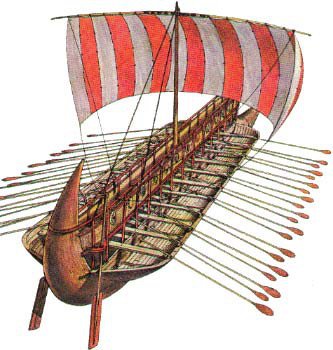
THE TRIRREME
It was the most formidable and sophisticated warship of the time. Sometime in the sixth century BC a third row of rowers was added to the traditional bireme.
The material used for the construction of the trireme was wood, but not of any kind. Fir, cedar and pine were used, with preference for fir, which was more fibrous and therefore lighter.
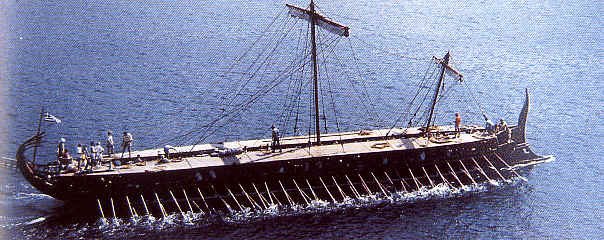
SAILBOATS
The age of sailing was a period in which international trade and naval combats were dominated by sailing ships, between the sixteenth century and the middle of the nineteenth century. This is a significant period during which sailboats transported colon-Europeans to numerous parts of the world in one of the most extensive human migrations remembered in history.
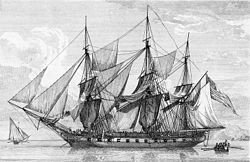
STEAMSHIPS
A steamboat, also called a much less frequent piróscafo, is a ship powered by steam engines, currently in disuse, or vapor porturbinas. It consists elementally of a steam boiler, a steam turbine or steam engine and a water-cooled condenser. The transmission is achieved with a crankshaft in steam engines or with a gearbox in the case of using turbines.
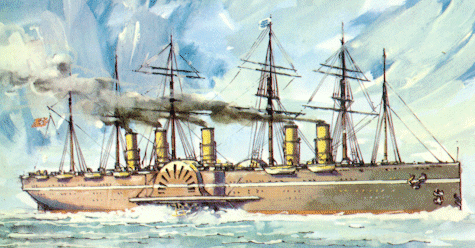
THE GREAT CRUISES
A cruise ship is a type of passenger ship for pleasure trips to any part of the world, being a unique, different and special way of traveling to know countries that are unexplorable through other means of transport.
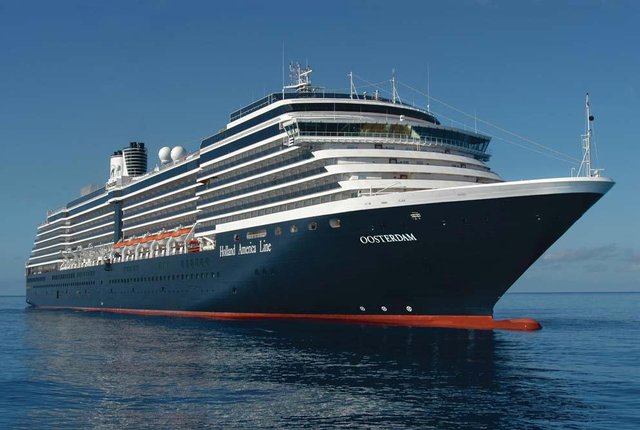
Undoubtedly, ships have been a large part of our history and our lives, taking the most important case that has been of a ship or ship that is the ark of noe and q by order of God, Patriarch Noah builds a boat for their salvation and that of their family who, preserved from the universal flood, would then repopulate the Earth with their offspring.